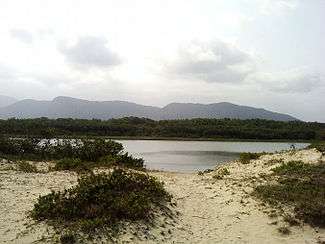Santos and South Coast
Santos and South Coast is a region in the state of São Paulo. It is formed by the Baixada Santista, a coastal metropolitan area with 1.6 million inhabitants centered on Santos, and the Paulista part of the Ribeira Valley, Brazil's largest area of primary Atlantic rainforest, part of the Atlantic Forest South-East Reserves, a UNESCO World Heritage Site.
Regions

- Baixada Santista (Bertioga, Cubatão, Guarujá, Itanhaém, Mongaguá, Peruíbe, Praia Grande, Santos, São Vicente)
- Ribeira Valley (Barra do Turvo, Cajati, Cananéia, Eldorado, Iguape, Ilha Comprida, Iporanga, Jacupiranga, Juquiá, Miracatu, Pariquera-Açu, Registro, Tapiraí)
Cities
- 🌍 Bertioga - Relatively tranquil beach city not far from São Paulo
- 🌍 Cananéia - A nice historic center and access to the unspoiled Cardoso island
- 🌍 Eldorado - Surrounded by Atlantic Forest, contains the Famous Devil's Cave (Portuguese: Caverna do Diabo)
- 🌍 Guarujá - Lively beach city that can get quite crowded, but has also some calmer beaches
- 🌍 Iguape - Containing one of the few Colonial historical centers of the state (a national heritage site), and the wild and huge Juréia beach
- Ilha Comprida - A long stretch of quiet beaches and sand dunes
- 🌍 Itanhaém
- 🌍 Mongaguá
- 🌍 Peruíbe - The paradisiac Barra da Una beach and aventure at the Juréia-Itatins Ecological Station
- 🌍 Santos - Brazil's largest port and home of F.C. Santos, with beautiful historical contructions of the coffee farming era
Other destinations
- 🌍 Jacupiranga Conservation Units - Previously called "Jacupiranga State Park", it contains a large original Atlantic rainforest reserve, the famous "Caverna do Diabo" (Devil's Cave) and the beautiful Lagamar de Cananéia
- 🌍 Alto Ribeira State Touristic Park - One of the largest original Atlantic rainforest reserves of the country, hence with large animal biodiversity, also with the highest concentration of caves in the World
Understand
Without doubt, the South Coast is where the São Paulo state was born, with the foundation of the São Vicente village in 1532. The early years of the region where marked by violent fights between Portuguese settlers and native Brazilians, and by the difficulty of Portuguese settlers on achieving economical prosperity. This second factor has lead to expeditions to the inner part of the state, the so-called Bandeiras, with the expeditioners, the Bandeirantes, becoming major historical figures in the state.
The region would have many economical ups and downs until the XIX century, when the boom of coffee farming happened. Santos quickly became the most important port of Brazil, a status that it maintains until nowadays, thanks to the industralization era that started in the 1950s. The surrounding cities became either dormitory cities for workers of the port of Santos, or beach resort towns for Paulistas. Eventually those cities conurbated with Santos, forming the metropolis known as Baixada Santista.
In the south of the region, the Ribeira Valley, on the other hand, never recovered from economical stagnation. This fact, while keeping the cities from the region small and relatively poor, ironically contributed to the preservation of the region's Atlantic rainforest, beaches and Colonial-era (pre-XIX century) historical heritage - making the region a true unspoiled gem in the state.
Get in
Get around
See
- The Casa de Pedra cave, in the Alto Ribeira State Touristic Park, the cave with the largest mouth in the World
- The valuable XIX century historical heritage of Santos, the Colonial historic centers of Iguape and Cananéia
- The Memorial das Conquistas in Santos, a museum about the history of the F. C. Santos football team, where Pelé played
- Cardoso island in Cananéia, a natural paradise guarded by rigorous protection laws
Do
Eat
Drink
Stay safe
Crime is a major problem in the Baixada Santista metro area, with only Bertioga being relatively safe. Walking at night should be restricted to well-trafficked areas. The Ribeira Valley is not particularly dangerous for visitors, although one must remember that it is a poor region, where one must avoid displaying possessions and entering very poor areas.